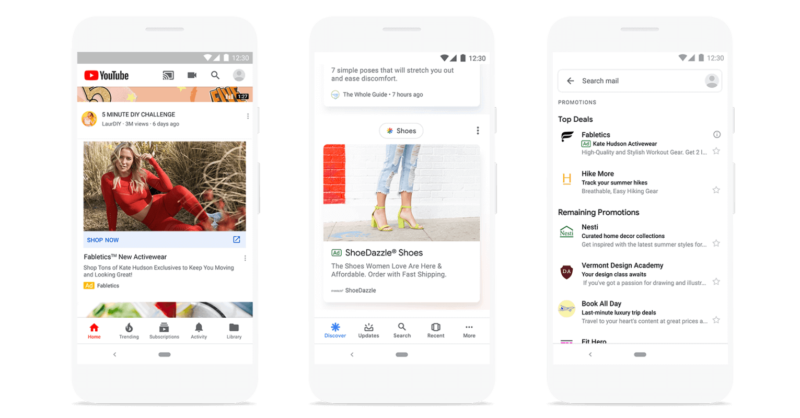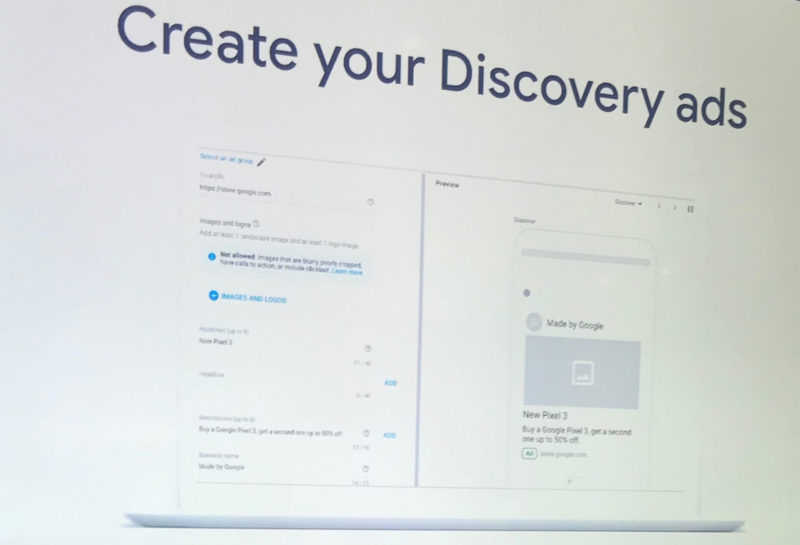New native Discovery ad campaigns from Google monetize Discover feed for first time
Discovery campaigns run across YouTube home feed, Gmail social and promotions tabs and Google Discover feed. The company says 800 million people now use Discover monthly.
SAN FRANCISCO — “A key theme this year is discovery,” Google’s Brad Bender, who leads its display and video advertising business, announced in a Google Marketing Live preview for reporters Tuesday. New ad products are designed to reach and communicate to people “not only when they are looking for something specific, but also when open to discovering something new,” said Bender.
The new Discovery ads squarely fit that theme, with visual formats that run across YouTube home feed, Gmail and, for the first time, the Google Discover feed. And they are enabled through a new Discovery campaign type that — to build on the theme — are targeted with audiences, not keyword-based search intent targeting.
[See our roundup of Google Marketing Live 2019 announcements here.]
Discovery campaigns: another automated, multi-channel campaign type. Advertisers must launch a Discovery campaign to run discovery ads. The new campaign type in Google Ads fits the mold of what started with Universal App campaigns (now just called App campaigns) in which advertisers upload their assets, throw in some copy ideas, and the ad serving gets handled entirely automatically across a number of Google properties.
They are set to roll out globally later this year.
Where can they show? Discovery campaigns can show automatically on the Google Discover feed, YouTube home feed and the social and promotions tabs in Gmail.
What is Discover? It is a feed (first known as Google Now, then Google Feed) that appears on the home page of the Google app for iOS and Android and the Google.com homepage on mobile. Users can customize their feeds to include topics of interest to them. Google began testing ads in Discover last fall with a small set of advertisers.
Depending on users’ account settings, Google may use web and app activity, device information, location history and home location to personalize feed content, which is largely AMP enabled.
Turns out Discover has become a quiet giant for Google. The company claims more than 800 million people use Discover monthly.
What do discovery ads look like? It depends where they are showing. In Gmail, they look and function just like regular Gmail ads. On YouTube and Discover, they look like native in-feed ads with large images — another trend, see the new Gallery ads and the expansion of Showcase shopping ads — as well as a headline and short description. The ads on YouTube also include a call-to-action banner. Examples of each are shown above.
Discovery campaign targeting. The targeting is based on Google audiences: interest, in-market, affinity. Advertisers can also use custom intent audiences. Those audiences are generated based on signals spanning Google properties, including users’ search activity, YouTube watch behavior, visits to Google Display Network sites, and apps downloaded from Play store.
Setting up Discover ads. Below is the creative set up screen for Discovery campaigns. You enter a landing page URL, upload at least one landscape image and one logo image. Images can’t be blurry, poorly cropped or include calls to action or clickbait.
You may enter up to 5 headlines and up to five descriptions for testing. A preview shows how the ad will look as you enter components.
How are they charged? Discovery ads are charged on a cost-per-click basis.
Why we should care? Discovery campaigns highlight ways in which Google is taking advantage of its multiple properties and host of audience data to automate ad targeting and serving across its ecosystem. It’s also an indication of Google looking beyond search intent to cover the entire funnel.
Discovery campaigns take their cue from Facebook’s success at exactly this type of visually impactful, native ad format targeted based on audience data rather than search intent. Google might have failed at establishing a social network with Google+, but it turns out it doesn’t matter — from an ads standpoint at least. Google has the intent data signals and inventory surfaces to make a play for fuller funnel, visually interesting, audience targeted, native ads without a social network.
Related:
Contributing authors are invited to create content for Search Engine Land and are chosen for their expertise and contribution to the search community. Our contributors work under the oversight of the editorial staff and contributions are checked for quality and relevance to our readers. The opinions they express are their own.
Related stories
New on Search Engine Land

